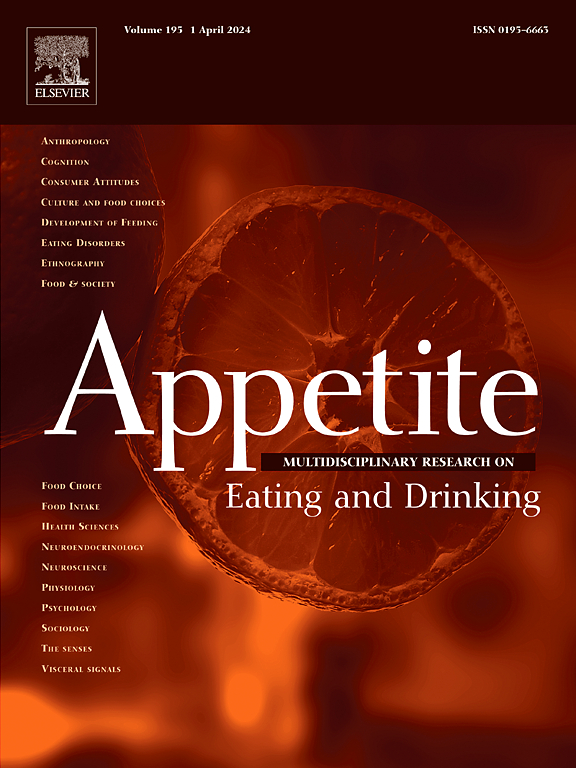Tracking the shift from health to harm: Development and validation of a short screening tool for orthorexia nervosa (STONE)
IF 3.8
2区 医学
Q1 BEHAVIORAL SCIENCES
引用次数: 0
Abstract
Orthorexia Nervosa (ON), a problematic fixation on healthy eating, has captured researchers' attention for over a decade. We aimed to develop a brief screening tool for ON that captures physical appearance as a motivating factor, behavioural aspects (rigid control over food selection, consumption and preparation), and nutritional aspects (avoidance of foods considered “impure”). Using a sequential, iterative design, 687 participants completed a self-reported survey across four studies: item identification and selection through exploratory factor analysis (n = 248), testing factorial construct validity with confirmatory factor analysis (n = 127), discriminant validity via known group differences (n = 241), and test-retest reliability of two subsequent administrations of the selected items (n = 71). The final unidimensional version of the short Screening Tool for Orthorexia Nervosa (STONE) comprises eight items. It demonstrated excellent known-group validity and ability to differentiate ON from other types of strict dietary control (e.g., health-based or religious restrictions). Consistent with the view of ON as behaviours aimed at rigid dietary control, avoidance of "impure" foods, and motivation to enhance physical appearance, STONE scores positively related to measures of eating pathology and appearance orientation, while only weakly correlating with obsessive-compulsive tendencies. Based on its psychometric properties, STONE is recommended as a first-level screening tool for ON in research contexts and epidemiology studies among adults. Due to its brevity, it can be easily combined with other scales to explore ON or related phenomena. Future studies should examine convergent validity and test it among adolescents and in different cultural contexts.
跟踪从健康到危害的转变:神经性正畸症(STONE)短筛选工具的开发和验证。
神经性正食症(Orthorexia Nervosa,简称ON)是一种对健康饮食有问题的执着,十多年来一直引起研究人员的注意。我们的目标是为ON开发一个简短的筛选工具,将外表作为激励因素,行为方面(严格控制食物的选择,消费和准备)和营养方面(避免被认为是“不纯”的食物)。采用顺序迭代设计,687名参与者完成了四项研究的自我报告调查:通过探索性因素分析进行项目识别和选择(n = 248),通过验证性因素分析测试析因结构效度(n = 127),通过已知组差异进行判别效度(n = 241),以及对所选项目的两次后续管理进行重测信度(n = 71)。最终的单维版正畸神经性筛查工具(STONE)包括八个项目。它显示了出色的已知组效度和区分ON与其他类型的严格饮食控制(例如,基于健康或宗教的限制)的能力。与ON的观点一致的是,它是一种旨在严格控制饮食、避免“不纯”食物和提高外表的动机的行为,STONE的得分与饮食病理学和外表取向的测量呈正相关,而与强迫倾向的相关性很弱。基于其心理测量特性,STONE被推荐作为成人研究背景和流行病学研究中on的一级筛查工具。由于其简洁,它可以很容易地与其他尺度结合,以探索ON或相关现象。未来的研究应检验趋同效度,并在青少年和不同文化背景下进行检验。
本文章由计算机程序翻译,如有差异,请以英文原文为准。
求助全文
约1分钟内获得全文
求助全文
来源期刊

Appetite
医学-行为科学
CiteScore
9.10
自引率
11.10%
发文量
566
审稿时长
13.4 weeks
期刊介绍:
Appetite is an international research journal specializing in cultural, social, psychological, sensory and physiological influences on the selection and intake of foods and drinks. It covers normal and disordered eating and drinking and welcomes studies of both human and non-human animal behaviour toward food. Appetite publishes research reports, reviews and commentaries. Thematic special issues appear regularly. From time to time the journal carries abstracts from professional meetings. Submissions to Appetite are expected to be based primarily on observations directly related to the selection and intake of foods and drinks; papers that are primarily focused on topics such as nutrition or obesity will not be considered unless they specifically make a novel scientific contribution to the understanding of appetite in line with the journal's aims and scope.
 求助内容:
求助内容: 应助结果提醒方式:
应助结果提醒方式:


